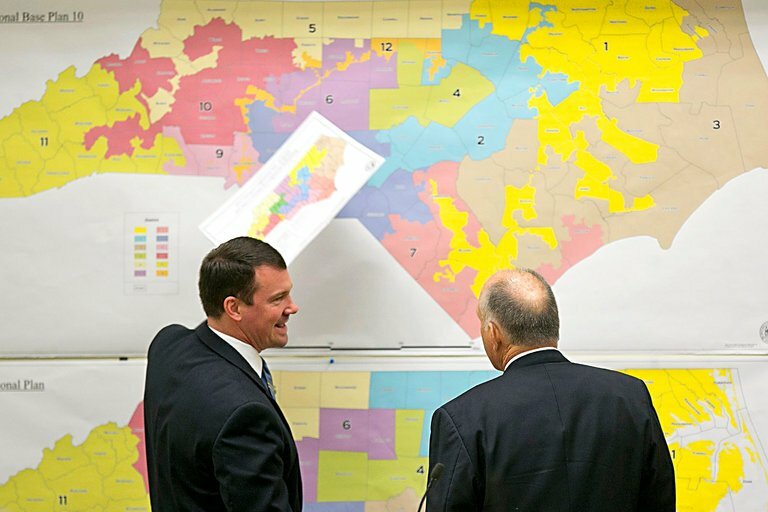In a previous Update I discussed two North Carolina redistricting cases—Harris v. McCrory and Covington v. North Carolina—both from the US District Court for North Carolina’s Middle District. In the course of that discussion I drew attention to Judge Cogburn’s concurrence in Harris in which he:
Condemned political gerrymandering:
Voters should choose their representatives…. This is the core principle of republican government…. As redistricting through political gerrymander rather than reliance on natural boundaries and communities has become the tool of choice for state legislatures … the fundamental principle of the voters choosing their representative has nearly vanished. Instead, representatives choose their voters. [quotation marks and citations omitted.]
Acknowledged that the courts are not in a position to stop it:
Redistricting to protect the party that controls the state legislature is constitutionally permitted and lawful…. Beyond taking offense at the affront to democracy caused by gerrymandering, courts will not … interfere.
And suggested that:
It is left to the people of the state to decide whether they wish to select their representatives or have their representatives select them.
Few would dispute Judge Cogburn’s first point, but—as a couple of more recent North Carolina redistricting cases show—when it comes to his second point things are a bit more complicated.
In Raleigh Wake Citizens Association v. Wake County Board of Elections and Wright v. North Carolina the plaintiffs challenged two identical redistricting maps: one enacted by the NC General Assembly in 2013 for the Wake County School Board, and another enacted in 2015 for the Wake County Board of Commissioners. When the cases were heard in the US District Court for North Carolina’s Eastern District last December the plaintiffs offered copious evidence, including hundreds of reports and other exhibits and the testimony of expert witnesses, all of which seemed to show pretty clearly that the maps were designed to give Republicans an electoral advantage. In spite of that evidence. the District Court ruled against the plaintiffs, which is what one would expect if “courts will not interfere” with political gerrymandering. However, when the cases reached the Fourth Circuit on appeal, two members of the three judge panel voted to reverse the District Court and found that the new maps for Wake County were, in fact, unconstitutional.
Does that mean Judge Cogburn was wrong about the courts and partisan gerrymandering? Certainly not. If redistricting to protect the party in power were unconstitutional hardly any district maps would pass constitutional muster. Moreover, in 2004 when the US Supreme Court dismissed a complaint alleging political gerrymandering in Vieth v. Jubelirer, four of the five-member majority agreed that, “Political districting presents a nonjusticiable question.” However, while districting to advance the interests of the party in power is lawful, districting that discriminates on the basis of race or violates the “one person, one vote” principle is not, and parties often claim racial discrimination or “vote dilution” when what they’re really concerned about is partisan advantage.
For example, in the redistricting cases I discussed in March the ostensible issue was whether the new plans violated the anti-discrimination provisions of the Voting Rights Act. However, as I said at the time, what the cases really showed was that:
Racial gerrymandering is no longer about race; it’s about politics. Why are the parties involved in this dispute interested in how black voters are apportioned among the various legislative districts? It’s not because those voters are black. It’s because those voters almost always vote for Democrats. The Republicans want to apportion them in a way that minimizes the number of Democratic majority districts, and the Democrats want the opposite.
In the Wake County redistricting cases, the ostensible issue is whether the new maps violate the “one person, one vote” principle that the US Supreme Court held (in Reynolds v. Simms) is inherent in the 14th Amendment’s Equal Protection clause. The plaintiffs, all of whom are Democrats, claim they do, whereas the Republican dominated state legislature that drew the maps claims they do not. In reality, however, neither side actually cares about vote dilution; instead, each side is seeking partisan advantage. This partisan advantage-seeking is possible because the Supreme Court’s jurisprudence regarding the one person, one vote principle has devolved into an unworkable mess. I discussed one aspect of that mess in a previous Update; the Wake County redistricting cases give me an opportunity to discuss another.
In 1974, in Gaffney v. Cummings, the Court suggested that maps with population variances of less than 10% should be presumed to be constitutional. Since the population between districts never varies by more than 7%, the new Wake County maps clearly fall within that “safe harbor.” However, in 2004 the Court cast doubt on the 10% rule. In Cox v. Larios it reviewed a lower court’s decision to strike down reapportionment plans enacted by the Georgia state legislature despite the fact that the population variation among the new districts fell within the 10% margin. The Supreme Court upheld the lower court’s decision, citing, by way of explanation, evidence of:
A deliberate and systematic policy of favoring rural and inner-city interests at the expense of suburban areas north, east, and west of Atlanta [and] an intentional effort to allow incumbent Democrats to maintain or increase their delegation, primarily by systematically underpopulating the districts held by incumbent Democrats, by overpopulating those of Republicans, and by deliberately pairing numerous Republican incumbents against one another.
Writing for the majority in the Wake County redistricting cases, Judge Wynn acknowledged that Larios leaves the 10% safe harbor rule in a muddle:
The Supreme Court has not yet clarified when exactly partisan considerations cross the line from legitimate to unlawful.
And he also acknowledged Justice Breyer’s statement, in the Supreme Court’s most recent one person, one vote decision, that:
Attacks on deviations under 10% will succeed only rarely, in unusual cases.
Nevertheless, he said:
After reviewing this matter closely … we are convinced that these mid-decade, partisan redistricting plans constitute just such an unusual case.
Whether the new plans actually do “cross the line from legitimate to unlawful” remains to be seen. Judge Motz filed a forceful and well-reasoned dissent, and the State of North Carolina has indicated that it will appeal. Given the muddled state of federal election law, it will probably come down to a judgment call in the end, and it seems inevitable that party politics will play a role in the ultimate disposition. Moreover, like the previous North Carolina redistricting cases, the dispute will end up costing a lot of money that could have been put to better use.
Such wasteful legal battles are inevitable as long as we go on leaving the redistricting process to politicians. However, we don’t have to do that. As Judge Cogburn reminded us:
It is left to the people of the state to decide whether they wish to select their representatives or have their representatives select them.
The people of other states have decided to take the latter course by assigning the task of redistricting to independent commissions. The people of North Carolina should follow their example.


